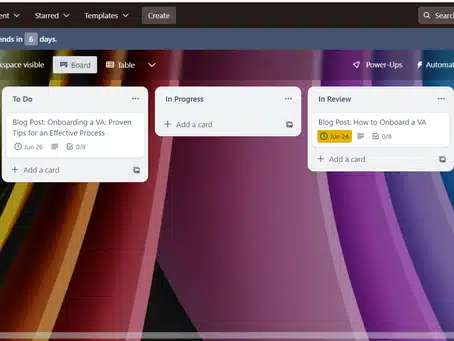1. Sign a contract with the VA
A formal contract outlines the terms of the working relationship and helps the VA understand their responsibilities and the scope of their role. A contract typically includes details such as:
The VA’s daily working hours and responsibilities
-
The mode of communication
-
Payment information, including rates and methods of payment
-
The expected daily production
-
Performance expectations, including quality standards and timelines
-
Non-solicitation/competition
-
NDA
-
And more
Tip: Use simple language in the contract so it doesn’t leave room for different interpretations.
2. Record a video introduction
An introduction video is a great way to familiarize the VA with your company’s culture, goals, what you’re trying to accomplish, and what’s their role in it. A proper introduction is also an excellent opportunity to explain what makes the relationship last and what doesn’t.
You can record yourself addressing them, or if you’re uncomfortable doing so, record a presentation. The video doesn’t have to be complex; a clear, concise presentation with thorough verbal explanations will suffice.
In larger companies, these videos can serve as a means for senior management to communicate messages since it’s difficult for them to have a direct conversation with each newly onboarded VA.
A checklist of points to cover in the video:
✅ A quick introduction about you and your company.
✅ 2-3 main values that you want the VA to remember. For example, proactive communication.
✅ A detailed overview of the VA’s project.
✅ Why the project is essential for your company.
✅ What is expected of the VA.
✅ What growth opportunities will be available for the VA (if any).
3. Create “How-To” guides
Want the VAs to do the assigned tasks properly? Help them do that by creating “how-to” guides for them. A step-by-step explanation will help the VA understand the process and implement it.
The VA will likely have questions or doubts as they learn new processes. By providing them with a detailed guide, you save time that would otherwise be spent clarifying their doubts.
You could create one on Google Docs and combine it with a recorded explanation. Some people learn better visually, and some require a verbal explanation. So a combination of a written guide + recorded explanation will usually be the best.
Here are some tips for creating effective “How-To” guides:
-
Use simple and clear language
-
Include screenshots or visuals to make the instructions easier to follow
-
Break down complex processes into smaller steps
-
Provide examples where possible
-
Use a consistent format to make it easy to follow and navigate
4. Use a task or project management tool
A task management tool is one of the things you will require in your onboarding process.
It will help you organize and track the progress of the VA’s work. Several tools are available for this purpose, and many have free versions suitable for small teams.
Try few tools like Asana, Trello, and ClickUp. Then select the one that suits your needs. We prefer Trello at Klarecon and recommend using it for its ease of use. Trello allows for easy collaboration, task assignment, and progress tracking.
It also allows you to create reusable templates for specific tasks or projects.

5. Set up a workflow
This involves identifying the key steps required to complete a project or task and organizing them logically.
Here’s an example of a non-automated basic flow:
Let’s say you want your Social Media VA to create posts for Linkedin. The process will consist of the following steps:
-
The task assigner opens a task in the To-Do column using a template.
-
The VA moves the task to the Doing column when they start working on it.
-
Once done, they move it to the Review column.
-
If any fixes are required, the reviewer returns the task to the Doing column and leaves a comment. The VA then performs the fixes and gets approval.
-
Upon completion, the VA moves it to the Scheduled/Done column and uses the correct label to indicate the status.
Here’s how the workflow will look on Trello:

6. Use checklists
After working with hundreds of remote VAs and freelancers, we’ve seen firsthand the benefits of working with checklists. A major one is that no one has to rely on memory to remember important steps in a process.
For example, if you want the VA to issue an invoice for your clients, here’s what a sample checklist could look like:
✅ Open the X dashboard to create an invoice
✅ Ensure the date format on the invoice is MM/DD/YY
✅ Verify the invoice amount with the payment sheet
✅ Download the invoice in PDF form
✅ Rename the invoice in this format: [ClientName] Invoice [Date (MM/YY)]
✅ Upload the invoice to the X folder of Google Drive
By reviewing completed tasks and comparing them to the checklists, you can identify which steps may have been skipped or completed incorrectly. This allows you to provide feedback and support to the VA so they work more efficiently in the future. You can also identify deliberate errors, facilitating constructive criticism in your performance measurement process.
7. Use a cloud storage platform
Saving materials on cloud storage platforms such as Google Drive or Dropbox is essential for remote collaboration. This makes it easy for the VA to access important materials and resources. It also ensures that the materials are organized and accessible for future use.
If any technical issues arise with your project management tool and it experiences downtime, the VA will still have access to the resources.
8. Create an onboarding checklist to monitor progress
An onboarding checklist is simply a list of tasks or steps you and the VA must complete before they start working. Having a checklist lets you easily monitor progress and ensure nothing is missed.
Using an onboarding checklist also helps to specify a sequence of tasks. For example, it makes sense to watch the introduction video first before going through any task-related guidelines. A step-by-step presentation of information results in a better understanding of how things work.
By now, you must have noticed that we often advise working with checklists. It’s because they make your job easier. Your brain can remember a lot but making it remember routine tasks and steps is not the best of use it.
Important: Add due dates to the checklist. By incorporating specific deadlines for each task, you communicate your expectations to the VA regarding the pace at which the onboarding process should progress. Setting due dates fosters a sense of urgency, promotes the timely completion of tasks, and ensures that the onboarding process stays on track.
9. Establish a reporting system
A reporting system will allow you to keep track of the VA’s progress, identify issues, and provide feedback.
You don’t want to chase the VA, and at the same time, you want to stay updated on what’s happening and have a clear idea of their efficiency.
Implementing a streamlined reporting system eliminates the need for daily inquiries and ensures you have the necessary information whenever required. It also gives you a fair idea of how sincerely the VA follows protocols.
You can also identify potential gaps or opportunities, such as:
-
Why the VA takes X hours to complete a task when it should take only Y hours? (X > Y)
-
The VA is quite good at writing, I can use them to draft my routine emails as well.
-
This project is early on its schedule. I should prepare another project so that by the time the VA is done with this one, the other one is ready to start.
10. Follow-up
After the VA has gone through the information and resources you provided, do a follow-up with them. This is a crucial step because it allows you to have an idea of whether the VA actually understands what they need to do and how they need to do it.
Ask random questions related to what they learned during the onboarding and analyze their answers. Does it look like they have clarity on how to go about their routine and the tasks? If not, it’s advisable they go through the resources again. This is where your process comes in handy. Because you have recorded materials and a proper system, you don’t need to do anything, even if the VA needs to repeat a few steps in the onboarding process.
During the follow-up, encourage them to provide feedback on the onboarding process. You may realize a critical missing step, which you can add and improve the process.
Did you find this article helpful? If yes, share it with your colleagues or peers who might benefit from it.
If you’re considering hiring VAs for your business but are unsure if you should, let’s talk. We’ll help you figure it out. Use this link to book a call with one of our consultants.





